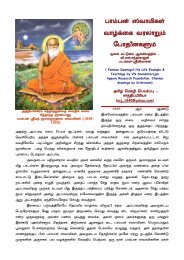Murugan Devotion among Tamil Diaspora - Murugan Bhakti
Murugan Devotion among Tamil Diaspora - Murugan Bhakti
Murugan Devotion among Tamil Diaspora - Murugan Bhakti
You also want an ePaper? Increase the reach of your titles
YUMPU automatically turns print PDFs into web optimized ePapers that Google loves.
<strong>Murugan</strong> <strong>Devotion</strong> <strong>among</strong> <strong>Tamil</strong> <strong>Diaspora</strong><strong>Murugan</strong> <strong>Devotion</strong> <strong>among</strong> <strong>Tamil</strong> <strong>Diaspora</strong>by Patrick HarriganMurukan devotion in the Indian Oceanregion is, ina sense, asold as thestory of<strong>Murugan</strong>Himself. Asancientlegends tellus, long agoLord<strong>Murugan</strong>descended toearth in theHimalayasand,impelled forwhateverreason,turned southtowards theDeccan andbeyond to<strong>Tamil</strong>akamLord <strong>Murugan</strong> and His entourage land in Lanka at Katirkamam after crossing the ocean. Templepainting from Sri Subramanya Swami Devasthanam Kumra Vayalurhttp://murugan.org/research/diaspora.htm (1 of 8) [2/21/2002 9:51:16 PM]
<strong>Murugan</strong> <strong>Devotion</strong> <strong>among</strong> <strong>Tamil</strong> <strong>Diaspora</strong>where,according tolocal and SriLankantradition, atTiruchendurHe crossedthe darkwater.Landing onthe shore ofLanka, Hecrossed thelength of theisland insearch of themaiden ValliAmma andfound her inthe jungle ofKatirkamam,where heeventuallysettled andmarried tobe joinedonly later byhis northernhttp://murugan.org/research/diaspora.htm (2 of 8) [2/21/2002 9:51:16 PM]
<strong>Murugan</strong> <strong>Devotion</strong> <strong>among</strong> <strong>Tamil</strong> <strong>Diaspora</strong>spouseDevasena(<strong>Tamil</strong>:Teyvaynai). [1]Historically,too, Lankaappears tohave beenthe first landoutside ofMother Indiawhere<strong>Murugan</strong>bhakti tookroot andflourished.Lanka mayhave beenthe firstSydney Murukan Temple gopuram and entranceSee "Murukan worship in Australia" by Dr Arumugam Kandiah .outpost of <strong>Murugan</strong> devotion in the Indian Ocean, but it was hardly the last. By the eleventh centuryC.E., devotion to Skanda-<strong>Murugan</strong> had reached Java in the Indonesian archipelago, leaving evidencein the form of sculptural artifacts. [2] Indeed, respect for the deity Skanda-<strong>Murugan</strong> eventuallyextended even to Buddhist societies far to the north and east, including Tibet [3] , China [4] and Japan. [5]http://murugan.org/research/diaspora.htm (3 of 8) [2/21/2002 9:51:16 PM]
<strong>Murugan</strong> <strong>Devotion</strong> <strong>among</strong> <strong>Tamil</strong> <strong>Diaspora</strong>Yet, with the exception of Lanka where <strong>Tamil</strong> community took root long ago and has remained eversince, it was only with the rise of international trade in the 18 th and 19 th centuries that <strong>Tamil</strong>s in searchof a better economic opportunities ventured to cross the Indian Ocean and settle in far-off lands suchas Africa, Mauritius, Seychelles and Reunion Island to the west, or Burma, Malaya, Singapore,Australia and even Fiji to the east. Most were simple rural folk, often landless, who signed on asindentured labourers on the great rubber, coconut and sugar estates that were the mainstay of earlycolonial economies in the region. Others of the Chettiar community set out in search of opportunitiesin the field of trade and commerce. Still others were recruited from India and Sri Lanka for theirexpertise as administrators.Everywhere <strong>Tamil</strong>s were respected and sought out fortheir well-deserved reputation as industrious, enterprisingfolk. But they also were – and remain – very conscious oftheir ancient cultural and religious heritage. So it comes asno surprise that <strong>Tamil</strong>s of every economic stratum werenot content merely to eke out a living and climb theeconomic ladder, but wanted to observe the same festivals,customs and practices that their ancestors had long takenfor granted.However, from the very beginning there have been obstacles to overcome. Those who first crossed theIndian Ocean were relatively few in number, and usually did so out of economic need. Few, if any, ofthem were religious specialists, and most traditional Hindu priests were, until recently, unwilling orextremely reluctant to leave India and cross the waters, which at that time entailed the loss of one'scaste standing in the eyes of many Hindus. In most instances, <strong>Tamil</strong> diaspora communities couldscarcely afford to import religious specialists or, when they could, only non-agamic pujaris could bepersuaded to resettle abroad. Added to this, the colonial administration, while recognizing Christianholidays and encouraging church attendance, with few exceptions refused to recognize Hinduhttp://murugan.org/research/diaspora.htm (4 of 8) [2/21/2002 9:51:16 PM]
<strong>Murugan</strong> <strong>Devotion</strong> <strong>among</strong> <strong>Tamil</strong> <strong>Diaspora</strong>festivals, for the large estates could not afford to suspend operations regularly due to mass absenteeism<strong>among</strong> the rank and file <strong>Tamil</strong> labourers.Despite such obstacles, <strong>Tamil</strong>s --especially womenfolk -- did preservehousehold rituals and much more. Inevery <strong>Tamil</strong> community, many weredevoted to Amman, Civan, Pillaiyar,Narayanan and, of course, <strong>Murugan</strong>,whose name has always beensynonymous with <strong>Tamil</strong> language,culture and religion. The most devoted<strong>among</strong> then either appealed to theirbrethren for help to construct a simplekovil or, more often, would proceed tobuild a shrine or kovil themselves,Periya Kovil: Sri Siva Subramaniya Temple - Nadi, Fijihowever rustic at first.Each <strong>Tamil</strong> diaspora community has hadto wage its own unique struggle overgenerations to achieve economicprosperity while yet preserving its <strong>Tamil</strong>identity and ancestral traditions. Hence,each has its own story to tell of how ithas overcome obstacles peculiar to itsadapted homeland. It is fitting, therefore,that members of the respectivecommunities have provided detailedaccounts of their struggle overgenerations to establish themselves ashttp://murugan.org/research/diaspora.htm (5 of 8) [2/21/2002 9:51:16 PM]
<strong>Murugan</strong> <strong>Devotion</strong> <strong>among</strong> <strong>Tamil</strong> <strong>Diaspora</strong>distinct and prosperous communities thatcontinue to cultivate <strong>Murugan</strong> bhakti andreap the Lord’s arul despite their relativeisolation from the <strong>Tamil</strong> homeland.Philologists have observed that isolateddiaspora communities often preservetheir cultural heritage even morejealously than their brethren of themotherland. For instance, the mostarchaic Scandinavian customs andliterary traditions are preserved not inScandinavia, but in Iceland by Nordicfolk who emigrated there many centuriesago. And it is well known that Jaffna<strong>Tamil</strong>s preserve a dialect of <strong>Tamil</strong> that is,in many respects, closer to classicalAnnual Kavadi procession through Victoria, capital of Seychelles<strong>Tamil</strong> than the <strong>Tamil</strong> spoken in anydistrict of <strong>Tamil</strong> Nadu. Likewise, as Heinz Bechert has rightly observed, "Whereas the cult of Ceyonor <strong>Murugan</strong> was fully integrated into Saivism in South India, the god of Kataragama has retainedmany archaic features…" [6] Hence it is possible that centuries from now diaspora <strong>Tamil</strong>s may preservearchaic elements of <strong>Murugan</strong> worship, such as kavati, which could pass out of practice in the heartlandof the <strong>Murugan</strong> cultus where the impulse for mainstream religious innovation tends to be greater.http://murugan.org/research/diaspora.htm (6 of 8) [2/21/2002 9:51:16 PM]
<strong>Murugan</strong> <strong>Devotion</strong> <strong>among</strong> <strong>Tamil</strong> <strong>Diaspora</strong>The Second International <strong>Murugan</strong> Conference, hosted by theisland nation of Mauritius, is a fitting tribute not only to the<strong>Tamil</strong>s of Mauritius who have resolutely answered the call of theheart during long decades of separation from Mother India, but tothe entire <strong>Tamil</strong> diaspora throughout the Indian Ocean region andbeyond. Quietly and with little fanfare, they have held aloft theflame of devotion not only to their beloved deity Lord <strong>Murugan</strong>and His traditions, but also kindled within themselves and others apassion for <strong>Tamil</strong> language, religion and culture in all its myriadaspects and dimensions. Thereby they have not only honored theirancestral traditions and redeemed themselves as authentic <strong>Tamil</strong>Hindus, but they have also made it possible for the light of ancientwisdom traditions to shine for future generations as well.End Notes[1] Oral tradition preserved at Tiruchendur as told to the author during Kanta Sasti 1996 by M.S.Muttusubramaniya Deekshitar and correlated to Sri Lankan <strong>Tamil</strong> traditions of Katirkamam.[2] Hayati Soebadio (ed.) Art of Indonesia: Pusaka from the collections of the National Museum,(Periplus editions, 1992) page 75.[3] Iconographic traditions current <strong>among</strong> Tibetan Buddhists and shamanic Bön-po alike identify thelance-bearing (Skt. shakti-dhara) divine generalissimo both with Karttikeya and with the legend ofShambhala.[4] B.N. Mukherjee, "An Illustration of Iconographic Contact between Karttikeya and Manjusri inChina" in Buddhist Iconography, pp. 138-141.http://murugan.org/research/diaspora.htm (7 of 8) [2/21/2002 9:51:16 PM]
<strong>Murugan</strong> <strong>Devotion</strong> <strong>among</strong> <strong>Tamil</strong> <strong>Diaspora</strong>[5] D.T. Suzuki, Manual of Zen Buddhism[6] Heinz Bechert, "Skandakumara and Kataragama: An Aspect of the Relation of Hinduism andBuddhism in Sri Lanka" in souvenir of the World Hindu Conference, Colombo, April 1982.Related <strong>Murugan</strong> <strong>Bhakti</strong> resources:• Skanda-Murukan Conference home page• Program of Speakers and Activities -- Second International Conference• Speakers and Topics -- Second International Conference• Murukan Conferences: Master Index of Topics• Synopses of First Murukan Conference papers• Kataragama.org• Palani.org• Tiruchendur.orghttp://murugan.org/research/diaspora.htm (8 of 8) [2/21/2002 9:51:16 PM]


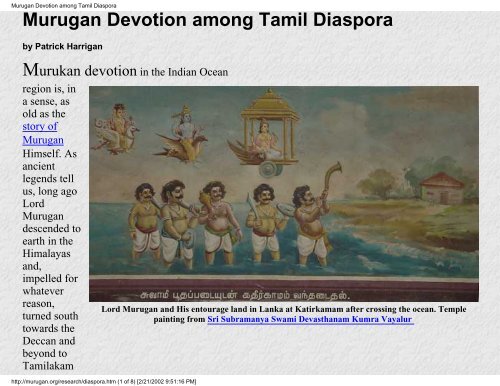
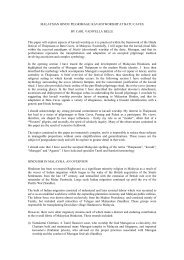
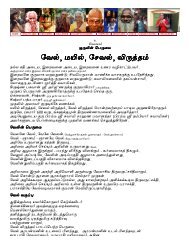
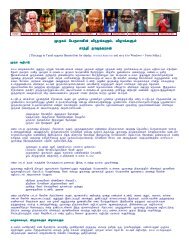
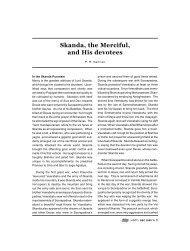
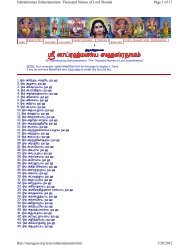
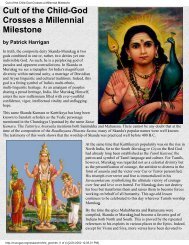
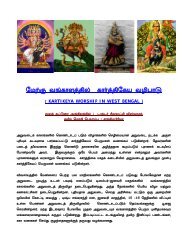
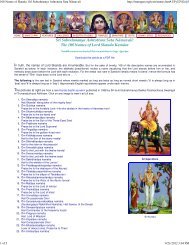
![gHdp k]y Myaj;jpw;F ghj ahj;jpiu fpuhkpa gHf;f Kiwfs;](https://img.yumpu.com/10245948/1/184x260/ghdp-ky-myajjpwf-ghj-ahjjpiu-fpuhkpa-ghff-kiwfs.jpg?quality=85)

